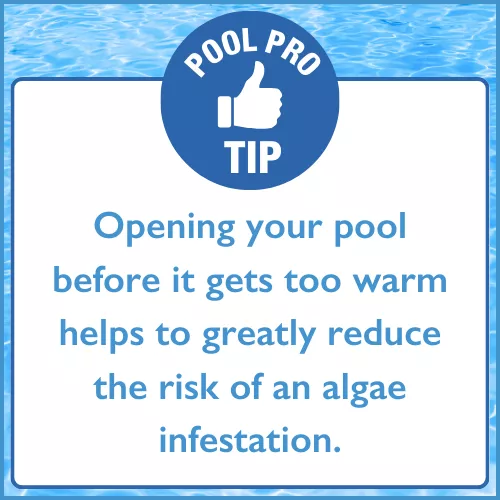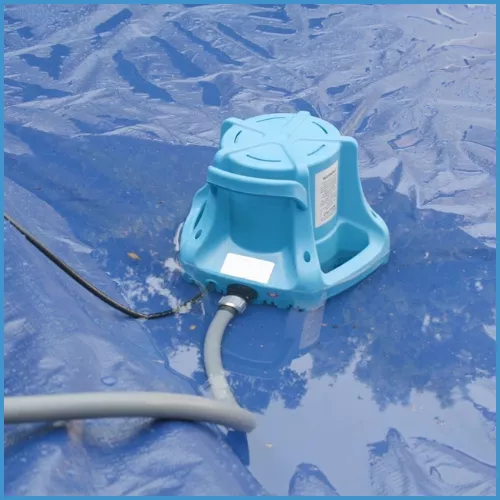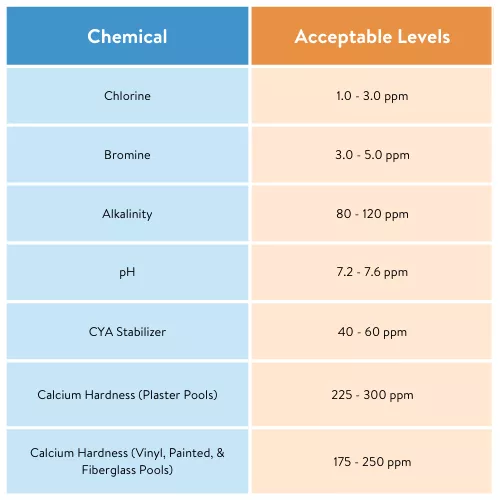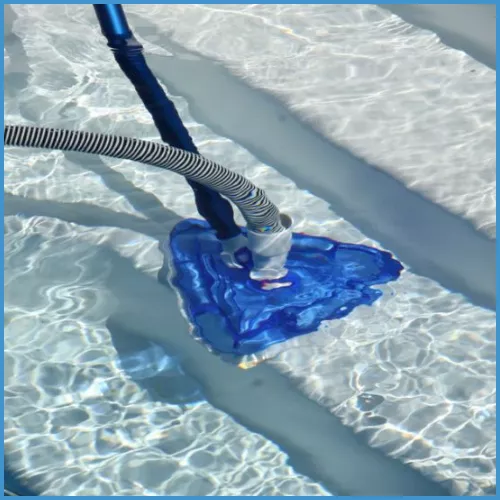

Pool season will be here soon and you may wonder, “how do I open my pool?” Opening a pool requires the right cleaning tools, high-quality pool chemicals, and a methodical approach.
The perfect time to open your pool is when the weather consistently warms up, typically in spring. This prevents potential freeze damage and gives you ample time to prep for the season. Make sure to open before the temperature gets too warm to prevent algae from starting to grow!


When you take the time to do the job right, you can enjoy crystal-clear water all season long. Cutting corners can give you much more work in the long run. The Pool Pros at Doheny’s have created this straightforward, comprehensive guide so you can confidently and easily open your pool for the season. We even have a pool opening checklist for first-time pool owners!
Download our Pool Opening Checklist here!
Clean Up Around the Pool
The landscaping around a pool can take quite a beating during the cooler months of the year. It’s not uncommon to find broken branches, leaves, and other debris piled up around your pool area once the snow melts. A great first step in pool opening is to clean up the area around your pool. Remove any large branches, get rid of any garbage that has blown into your yard, and trim up your landscaping.
Remove and Store Your Winter Cover
Once the area around the pool is clean, it’s time to clear off the winter pool cover. Remove all large pieces of debris with a leaf skimmer or leaf rake and use a pool cover pump to remove excess water from the pool cover. Removing as much water from the cover as possible will make it easier to remove and store the cover when not in use.


When the pool cover has been drained and cleared off, remove it from the pool. Solid pool covers tend to be fairly heavy, so always grab a partner for assistance to prevent accidents. Once the pool cover has been removed, rinse it off with a garden hose and allow it to completely dry while laid out flat on your lawn or patio. Inspect the pool cover for any signs of excessive wear and tear, as you don’t want to be surprised by damage once it’s time to close the pool. Replace your cover if it is damaged.
Before folding and storing the cover, apply a light coating of a mildew removal product to prevent mold from developing. Storing the cover in a protected, cool place where it will stay dry is the key to its longevity.
Check Your Pool, Equipment, & Chemicals
The best time to inspect your pool, chemicals, and equipment for problems is when you are performing pool opening activities.
- Pool Wear & Tear - Look around your pool for any signs of excessive wear and tear, including small cracks or chipping in the tile, as even the smallest spaces are prone to developing problems with mold and mildew.
- Inventory Chemicals - You need the right chemicals to open your pool and manage it throughout the season. Check to see what chemicals you currently have and order anything you still need for the season.
Replace Winterizing Plugs - Replace/re-attach the drain plugs that were removed from the pool filter, heater, pump, pool cleaners, and other items that were winterized last fall. Remove winter plugs from the return fitting(s) and skimmer if necessary. - Reinstall Deck Equipment - Begin reinstalling the deck equipment. Follow the provided instructions to install the pool slide, deck chairs, and extra railings, after inspecting items for damage when they come out of storage. If you’ve got a pool fence, set that up as well, as it’s never too early to start practicing smart pool safety.
- Reconnecting Electrical Equipment - For both above ground and inground pools, follow the manufacturer's instructions for connecting the pool heater, pool pump, and filtration system. Inspect the basket strainers for cracks and check that all lines are open and free from debris. It’s also a good idea to check for any leaks at the hose connections and to check your filters for wear and tear.


- Clean Equipment & Pool - Thoroughly clean all pool surfaces and pool equipment. Use a manual pool brush for some tough pre-treating action on especially dirty or stained areas of the pool floors and walls. Use a pool skimmer to scoop up debris from the pool water surface.
- Fill Your Pool - It’s important to fill your pool correctly in order to achieve maximum enjoyment and durability.
- Above Ground - Begin adding fresh water to the pool. Continue filling until the water has reached about 2⁄3 up to the skimmer opening. Make sure that the skimmer isn’t cracked or developing any leaks.
- Inground - Ensure all plugs and skimmer guards have been removed and fill the pool with water 2⁄3 up to the skimmer opening. Carefully check for leaks or cracks in the surface while filling to prevent problems later on in the season.


Test & Balance The Water
Once the pool has been filled with fresh water, it’s time to run the filtration system and get the water circulating. Before you turn on your filtration system, bleed any remaining air from the line (if you have an air relief valve) and prime the pool pump if necessary before use. Once the filtration system is on, check for leaks around the equipment and connections and vacuum your pool with a manual vacuum or automatic cleaner.
When you first begin running the filtration system, use a Doheny’s Start-Up Kit, choosing a size that suits your pool. These opening kits contain everything you need in one convenient package to get your water back in shape for swim season. They help balance the pH levels, sanitize the water, and prevent algae growth. Using a pool opening kit can save time and money by avoiding costly maintenance and repair issues that can arise from neglecting your pool during the off-season.


After your pool’s circulation system has run for at least 12 hours, it’s time to test pool water chemicals. Various factors affect your pool’s water balance that pool owners must monitor, including pH, total alkalinity, calcium hardness, total dissolved solids, sanitizer, cyanuric acid, temperature, and metal levels. Keeping each of these levels in check is essential to creating a safe swim environment and preventing harmful erosion, scale deposits, and staining of pool surfaces. Everything from environmental changes and basic use can alter your pool water chemistry, so it’s important to test the water frequently throughout the season. Learn more about balancing your chemicals on our Complete Guide to Pool Chemistry blog.


Optimal Chemical Levels
- Chlorine: 1.0 - 3.0 ppm
- Bromine: 3.0 - 5.0 ppm
- Alkalinity: 80 - 120 ppm
- pH: 7.2 - 7.6 ppm
- CYA Stabilizer: 40 - 60 ppm
- Calcium Hardness (Plaster Pools): 225 - 300 ppm
- Calcium Hardness (Vinyl, Painted, & Fiberglass Pools): 175 - 250 ppm
When testing your water and determining how much of each chemical to use, you need to know your pool’s gallonage.
1. Find your pool’s average depth:


2. Determine your pool’s capacity by shape:


Shock Your Pool
Shocking your pool during pool opening is one of the most important things pool owners can do to protect family and friends from dangerous bacteria and organic elements that can contaminate pool water. Pool shock is a highly concentrated chlorine product which “shocks'' pool water and kills off anything that is contaminating it. A pool shock treatment is designed to add 5-10 ppm Free Available Chlorine (FAC) to the water. This allows for better algae control and cleaner, safer water. After a successful pool shock treatment, your FAC levels should be 1-4 ppm, indicating it’s safe to be in the water. Before shocking your pool, balance the pool’s pH levels for the best results.


Final Closing Preparations
Your opening preparations are almost complete, and it’s almost swim time! Follow these final steps to finish getting your pool ready for the season.
- Run The Filtration System - Once you’ve cleaned the pool and added the appropriate pool opening chemicals, run your pool pump and filtration system again for at least 12 hours. This will help evenly distribute the chemicals through the water for the cleanest possible water. If your system isn’t working as well as it used to and you need an upgrade, consider doing so before the warm weather hits. You don’t want to be left with a broken pool pump in the middle of the season.
- Re-test Your Water - Once the filter is done running, test the levels of the chemicals in the water again. If the levels are still off, go through the process of testing the water, adding chemicals, running the filter, and testing again.
- Vacuum - A final vacuuming of your pool before you dive in will pick up any debris that may have fallen in during the pool opening process and will ensure that water will be perfect for that first swim. Use a pool water clarifier product to get rid of any remaining bits of debris that may remain.


Ongoing Maintenance
To keep your pool sparkling all summer, regular maintenance is key. Here are some essential tips for upkeep.
- Monitor and Adjust Pool Chemistry - Regularly test the water and adjust chemical levels. This prevents problems like algae growth, equipment or pool damage, and irritation to swimmers' skin and eyes.
- Regular Cleaning - A quick daily skimming and frequent vacuuming are essential to keep your pool at its best. Regularly brush the pool walls and tiles to prevent algae and other contaminant build-up. For more tips on removing algae, check out our algae removal blog.
- Addressing Pool Issues - Even with regular maintenance, issues can arise. Be prepared to promptly tackle common problems like cloudy water, low water levels, and equipment malfunctions.
- Keep The Area Clean - Keep the areas around your pool clean and free from debris. Remove debris that has fallen into the pool and trim any low-hanging branches that could end up in the water. Keeping your deck and patio areas tidy will help to keep your pool clean and safe.
- Run Your Pool Filter - To ensure you get the most out of your pool filtration system and chlorine, the pump should be operated as consistently as possible, preferably 24 hours a day. Doing so will help prevent algae and bacteria buildup, which will help save you money and keep your water fresh and clean all season long.
- Shock Your Pool - Shock your pool at least once a week. Try to shock your pool around the same time and on the same day of the week. Shocking a pool at sundown works best, as pool chlorine is most effective when it’s not competing against the sun’s harshest rays. Below are a few other instances when you should shock your pool:
- When stormy weather has blown rain or debris in the pool
- After a pool party or extended periods of use
- When there are long periods of extremely hot weather
- Once swimmers begin to complain about burning, irritated eyes
- When you begin to notice odors or signs of algae growth
- Once pool water begins to look cloudy, hazy or just plain dull
Follow these tips for pool opening & maintenance to enjoy a clean and well-maintained swimming pool all season. For top-quality pool maintenance products, check out the rest of our website at doheny.com.




